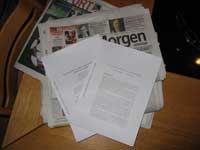[Last time][1] we saw that for $A$ a smooth order with center $R$ the
Brauer-Severi variety $X_A$ is a smooth variety and we have a projective
morphism $X_A \rightarrow \mathbf{max}~R$ This situation is
very similar to that of a desingularization $~X \rightarrow
\mathbf{max}~R$ of the (possibly singular) variety $~\mathbf{max}~R$.
The top variety $~X$ is a smooth variety and there is a Zariski open
subset of $~\mathbf{max}~R$ where the fibers of this map consist of just
one point, or in more bombastic language a $~\mathbb{P}^0$. The only
difference in the case of the Brauer-Severi fibration is that we have a
Zariski open subset of $~\mathbf{max}~R$ (the Azumaya locus of A) where
the fibers of the fibration are isomorphic to $~\mathbb{P}^{n-1}$. In
this way one might view the Brauer-Severi fibration of a smooth order as
a non-commutative or hyper-desingularization of the central variety.
This might provide a way to attack the old problem of construction
desingularizations of quiver-quotients. If $~Q$ is a quiver and $\alpha$
is an indivisible dimension vector (that is, the component dimensions
are coprime) then it is well known (a result due to [Alastair King][2])
that for a generic stability structure $\theta$ the moduli space
$~M^{\theta}(Q,\alpha)$ classifying $\theta$-semistable
$\alpha$-dimensional representations will be a smooth variety (as all
$\theta$-semistables are actually $\theta$-stable) and the fibration
$~M^{\theta}(Q,\alpha) \rightarrow \mathbf{iss}_{\alpha}~Q$ is a
desingularization of the quotient-variety $~\mathbf{iss}_{\alpha}~Q$
classifying isomorphism classes of $\alpha$-dimensional semi-simple
representations. However, if $\alpha$ is not indivisible nobody has
the faintest clue as to how to construct a natural desingularization of
$~\mathbf{iss}_{\alpha}~Q$. Still, we have a perfectly reasonable
hyper-desingularization $~X_{A(Q,\alpha)} \rightarrow
\mathbf{iss}_{\alpha}~Q$ where $~A(Q,\alpha)$ is the corresponding
quiver order, the generic fibers of which are all projective spaces in
case $\alpha$ is the dimension vector of a simple representation of
$~Q$. I conjecture (meaning : I hope) that this Brauer-Severi fibration
contains already a lot of information on a genuine desingularization of
$~\mathbf{iss}_{\alpha}~Q$. One obvious test for this seemingly
crazy conjecture is to study the flat locus of the Brauer-Severi
fibration. If it would contain info about desingularizations one would
expect that the fibration can never be flat in a central singularity! In
other words, we would like that the flat locus of the fibration is
contained in the smooth central locus. This is indeed the case and is a
more or less straightforward application of the proof (due to [Geert Van
de Weyer][3]) of the Popov-conjecture for quiver-quotients (see for
example his Ph.D. thesis [Nullcones of quiver representations][4]).
However, it is in general not true that the flat-locus and central
smooth locus coincide. Sometimes this is because the Brauer-Severi
scheme is a blow-up of the Brauer-Severi of a nicer order. The following
example was worked out together with [Colin Ingalls][5] : Consider the
order $~A = \begin{bmatrix} C[x,y] & C[x,y] \\ (x,y) & C[x,y]
\end{bmatrix}$ which is the quiver order of the quiver setting
$~(Q,\alpha)$ $\xymatrix{\vtx{1} \ar@/^2ex/[rr] \ar@/^1ex/[rr]
& & \vtx{1} \ar@/^2ex/[ll]} $ then the Brauer-Severi fibration
$~X_A \rightarrow \mathbf{iss}_{\alpha}~Q$ is flat everywhere except
over the zero representation where the fiber is $~\mathbb{P}^1 \times
\mathbb{P}^2$. On the other hand, for the order $~B =
\begin{bmatrix} C[x,y] & C[x,y] \\ C[x,y] & C[x,y] \end{bmatrix}$
the Brauer-Severi fibration is flat and $~X_B \simeq \mathbb{A}^2 \times
\mathbb{P}^1$. It turns out that $~X_A$ is a blow-up of $~X_B$ at a
point in the fiber over the zero-representation.
[1]: http://www.neverendingbooks.org/index.php?p=342
[2]: http://www.maths.bath.ac.uk/~masadk/
[3]: http://www.win.ua.ac.be/~gvdwey/
[4]: http://www.win.ua.ac.be/~gvdwey/papers/thesis.pdf
[5]: http://kappa.math.unb.ca/~colin/
